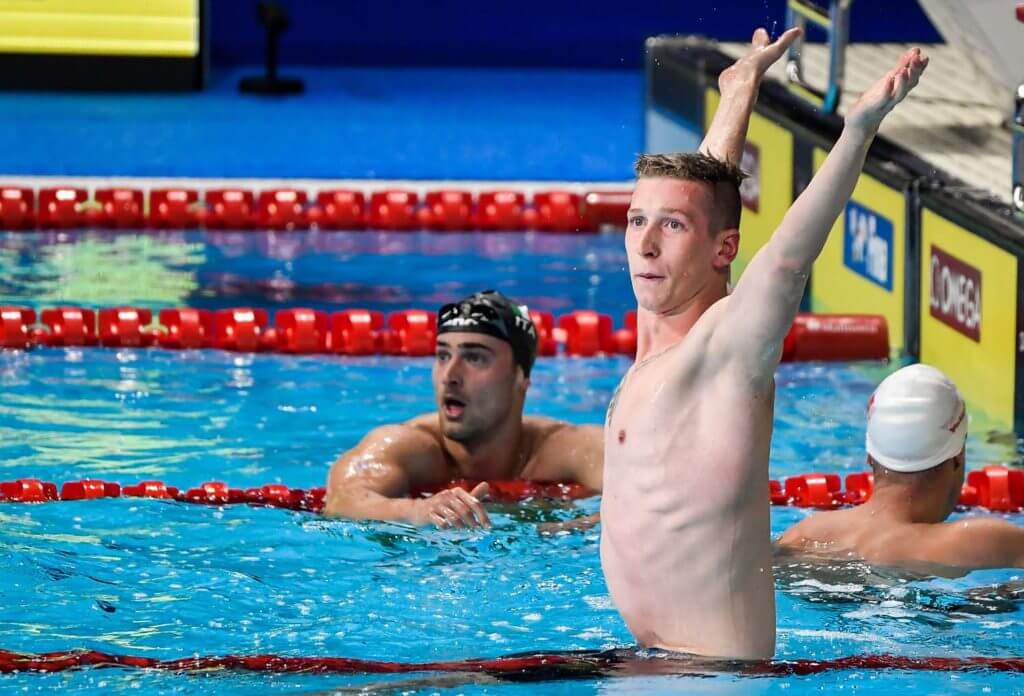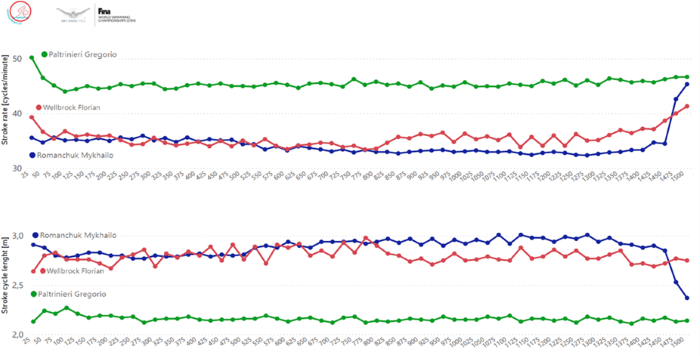Data Analysis: How Enhanced Turn Performance Led Florian Wellbrock to World Record in 1500 Freestyle (Visual Charts)

Data Analysis: How Enhanced Turn Performance Led Florian Wellbrock to WR in 1500 Freestyle (Visual Charts)
We witnessed a new world record in the men’s 1500-meter freestyle at the recent 2021 World Short-Course Championships in Abu Dhabi. For the present article, we compared the new world record of Florian Wellbrock to Gregorio Paltrinieri’s previous world record (2015 European championships in Netanya) and Mykhailo Romanchuk’s championship record (2018 World championships in Hangzhou) to provide a deeper insight and show some interesting details about these amazing performances.
Florian Wellbrock – 14:06.88 – Abu Dhabi – 2021
Mykhaylo Romanchuk – 14:09.14 – Hangzhou – 2018
Gregorio Paltrinieri – 14:08.06 – Netanya – 2015
Previous Champion Compared to Current World Champion: Romanchuk vs. Wellbrock
For the first step of the analysis, the last two short-course world champions are compared as both swimmers are characterized by a similar stroke profile (Fig 1). Both swimmers use a low stroke rate (34.22; 35.48) and long stroke length (2.89; 2.80) in contrast to Paltrinieri who typically uses a higher stroke rate (45.42) with a shorter stroke length (2.16). Based on an average stroke length of 2.62m across all three swimmers after a breakout distance of 4.30 m to 6.02 m (Fig. 2), turn performances were analyzed as 5m in + 10m out. This has previously been discussed in regard to the importance of the underwater phase for success in competitive swimming, in particular with the efficient transition to the arm strokes of the first swim cycles (Born, Kuger, Polach & Romann, 2021, Sports Biomechanics).

Fig. 1 Comparison of stroke rate and stroke length.

Comparison of breakout distance and velocity.
A previous research study published in BMC Research Notes (Polach, Thiel, Krenik & Born, 2021) found turn performances as a distinguishing factor for 1500m freestyle races and predicted a new short-course world record if turns would be performed with the same speed as in long-course races. Indeed, for the current world record, Wellbrock did not show as fast clean swimming times as Romanchuk in 2018 but gained time with greater turn performances. For the current world record, Florian Wellbrock turned in total 5.03s faster (difference between the sum of all turn times) compared to Romanchuk´s in 2018. (Tab. 1).

Table 1: Comparison of total section times: Wellbrock vs. Romanchuk.
One important contributing factor to Wellbrock’s faster turn times were the faster 5m in times compared to Romanchuk, which were partially attributed to faster rotation times (Tab. 2). From visual observation of the video footages, Wellbrock had a shorter gliding phase between the last arm stroke and the initiation of the rotation and performed the rotation closer to the wall. After wall contact, Romanchuk had faster 5m out times with higher velocities (2.87 vs. 2.68 m/s) compared to Wellbrock. Reasons can be found in the underwater distance. While Romanchuk was still underwater until in average 6.02m, Wellbrock transitioned to clean swimming in an average of 4.45m. However, with faster breakout velocites (2.91 vs. 2.56 m/s) and probably more efficient transitions to the first swimming strokes, Wellbrock gained time in the section between 5m and 10m out.

Table 2: Turn time analysis: Wellbrock vs. Romanchuk (Section split times are displayed as mean values).
Previous World-Record Holder Compared to Current World-Record Holder: Paltrinieri vs. Wellbrock
Analysis of the last two world-record holders provides us with similar findings. Wellbrock showed 2.30s faster total turn times and 1.42s slower clean swimming times than Paltrinieri (Tab 3).

Table 3: Comparison of total section times: Wellbrock vs. Paltrinieri
Paltrinieri had a shorter, yet faster underwater phase, resulting in faster 5m out times. However, between 5m and 10m out, Wellbrock gained in average 0.04s with each turn. Another 0.02s he gained when approaching the wall (5m in).

Table 4: Turn time analysis: Wellbrock vs. Paltrinieri (Section split times are displayed as mean values).
Conclusion
In summary, comparing all three swimmers, Wellbrock showed the slowest swim times but fastest turn times (Tab. 5). With a closer look at the turns, he was fastest at 5m in as well as in the section from 5m to 10m out. Optimal timing and distance for the initiation of the rotation when approaching the wall seem to be crucial as well as to find the individual breakout distance to optimize breakout velocity and transition to the first arm strokes of the clean swimming section.

Table 5: Summary of mean section split times of all three swimmers.
Obviously, turn and swim sections cannot be decoupled from each other. Energy invested in one section cannot be used in another. However, a substantial part of the current new world record was attributed to improved turn performances. The ideal combination of many technical details with physiological conditioning in the day-to-day training process and scientific analyses help to discover new potentials and develop toward the next performance level.
All commentaries are the opinion of the author and do not necessarily reflect the views of Swimming World Magazine nor its staff.



